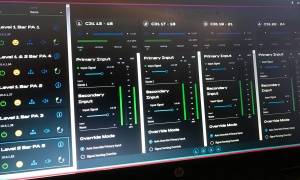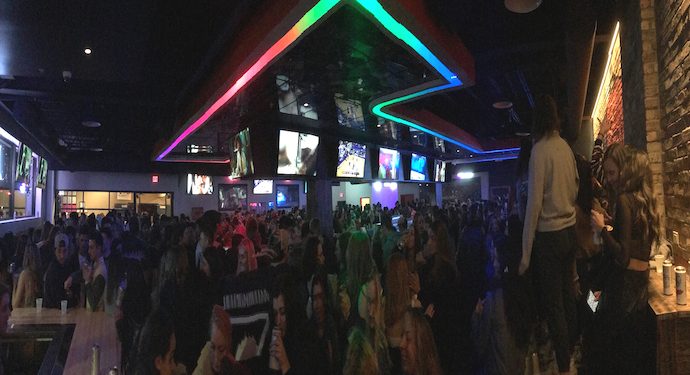Originally founded in 1933, Kam’s Bar, newly relocated on the campus of the University of Illinois at Urbana-Champaign, has been a mainstay of the Illinois college experience for generations. Consistently named as one of the top college bars in the country, Kam’s — the home of the Drinking Illini — has been the go-to hangout for students, faculty, alumni, and the local community to meet and relax, share drinks, conversation and music for decades. In the evenings, Kam’s becomes quite the nightspot as well with live DJs, dancing, and the full college drinking experience.
In the fall of 2019, the original Kam’s location was closed to make way for new development. The Kam’s name and brand were purchased by a local developer and restaurateur, Scott Cochrane, who owns three other Campustown bars and several other club locations in Champaign-Urbana. Cochrane and his team had a vision for re-opening a larger, updated Kam’s that captured the charm of the original but could accommodate a range of events with a comprehensive, state-of-the-art sound system and audiovisual support.
Champaign-Urbana based C.V. Lloyde Audiovisual has been providing pro AV design, sales, and installation services throughout Illinois for more than 150 years. With a deep-rooted philosophy that the quality of a professional system must not be compromised by the actual installation, C.V. Lloyde counts many of the region’s universities, stadiums, houses of worship, school districts, and corporate facilities among their long list of clients.
Stephen Morris, President and CEO, C.V. Lloyde Audiovisual, worked with the Cochrane team to design and install the AV system for the new Kam’s using LEA Professional amplifiers. The new, larger, two-story version of Kam’s features a highly-integrated AV system, including a network-based, fully-distributed AV system with video displays, full-range sound systems, digital signage, DJ booth, device-based control apps, and remote monitoring tools.
 “This was a fun project because Kam’s has a history, it has served decades of alumni, many who are now at Fortune 100 companies and they all remember Kam’s and cherish those memories, and they come back and share this unique experience with their kids and grandkids,” said Morris. “So Kam’s is very near and dear to everyone’s heart, and when the new owner, Scott Cochrane, decided to relocate and upgrade Kam’s, he was determined to do it right.”
“This was a fun project because Kam’s has a history, it has served decades of alumni, many who are now at Fortune 100 companies and they all remember Kam’s and cherish those memories, and they come back and share this unique experience with their kids and grandkids,” said Morris. “So Kam’s is very near and dear to everyone’s heart, and when the new owner, Scott Cochrane, decided to relocate and upgrade Kam’s, he was determined to do it right.”
Morris explained that while this is indeed a campus bar, it is not the traditional hang-and-bang AV type installation. Depending on local and college events and the bar’s theme nights, the system needed to be able to handle every type of music, from Hip Hop and EDM hits to classic rock from the 70s and 80s — and everything in between.
“Scott and his team did a beautiful job with the new Kam’s, capturing the charm, history and nostalgia of the bar and the University of Illinois,” said Morris. “On the second floor of Kam’s, there’s now a showcase of all the Champaign-Urbana bars over the years; it’s a real walk down memory lane of every bar and Tavern in the Champaign-Urbana area since the turn of the century. This facility is only a few months old, but it has roots.”
The new Kam’s opened briefly in February 2020, just before the coronavirus shelter-in-place announcement, but for several weeks the bar was open and enjoyed, and the team had time to dial in the system and experience it within the live environment. There was also a private grand opening for all the vendors and partners involved, followed by a public grand opening, which saw an hour-long line of patrons waiting to get in to experience the new Kam’s.
“The types of audio support they need is all over the map, so we wanted to be able to represent any genre and make sure we had plenty of amplifier headroom in the system to make the subs do what they need to do,” said Morris. “I’m happy to report that the place sounds great, there is plenty of headroom, allowing us to reach well over 100dB with less than 1dB plus or minus between all the public spaces of the main bar, the coverage is excellent.”
Behind the scenes, Morris selected a set of six, four-channel, 700-watt amplifiers from LEA Professional, specifically the LEA Connect 704D amplifier.
The Connect 704D is a professional-grade amplifier suited for small- to medium-scale installations, featuring three ways to connect. Users can engage the built-in Wi-Fi access point, connect to the venue’s Wi-Fi, or use the FAST Ethernet to connect to any local area network via Cat5 or Cat6 cable. The Connect Series also features cloud connectivity allowing users to harness the power of the cloud for remote control, monitoring, notifications, and more from any personal device. The Connect 704D also features HiZ and LoZ channel selectable analog inputs, Dante inputs, and external I/O control for remote on/off and fault monitoring.
“The overall sonic performance, responsiveness, and headroom of the amplifier have proven to be all that we hoped and then some. We’re pushing a good-sized, full-range set of JBL Control 28s, Control 31s, and AC115S subwoofers, which all take a lot of power, and the LEA amps are taking it all in stride.”
The C.V. Lloyde team also put a lot of design work into the control system. The audio system as a whole is a Dante environment, with analog and Dante digital audio inputs available throughout the facility, so there would be easy Dante inputs and access at all points, including the DJ booth. When there is no DJ, the bar managers use the system’s Bluetooth access to easily play and control music playlists from a smartphone or tablet. There is also a color, touch panel master control, but the mobile device connectivity allows managers to walk around the bar and manage sound levels for the multiple indoor and outdoor zones.
“There’s a beer patio outside, a second-floor deck and terrace, an outdoor patio and upstairs, downstairs, and a side bar — all of these different zones have their own zone control and volume control,” said Morris. “They all operate independently with a mix of private and public events happening simultaneously, so each zone has an autonomous capability to completely choose their own inputs and manage their levels independent of each other.”
With the temporary closure, the team has not had the chance to work with the available remote diagnostics and control for the system, but it is coming.
“We haven’t opened up our ports for the VPN to do remote diagnostics yet, which will allow us to look directly at the amplifier addresses remotely and monitor their performance, but we will,” said Morris. “Once that happens, I’m going to have my diagnostics and remote access online so we can constantly monitor the amps — this is a very interesting feature of the LEA products, and we’re glad to see that they put a lot of work into the diagnostic side of the amps.”
Morris added that C.V. Lloyde is currently designing new systems for a large hotel renovation and expansion with a convention center, a stadium project, and several other sports facilities, houses of worship, and multiple higher education environments, and he plans on specifying LEA Connect Series amplifiers into these systems where he can.
“At the end of the day, we do business with people who are easy to do business with, period,” added Morris. “When evaluating new products, I look for capable, reliable components that will fit the application as good or better than my other options, and that are built and supported by trustworthy teams. When these points come together, that’s a product and company I’m going to pay attention to, and LEA has brought these points together for me.”
















